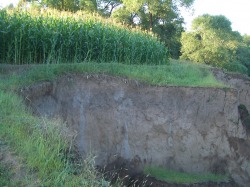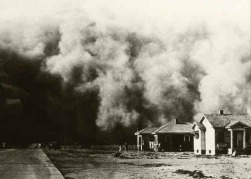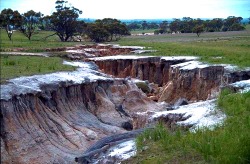What Is Erosion?
Wind or water erosion is the physical wearing of the earth’s surface. Surface soil material is removed in the process.
Measuring Soil Erosion

Visual, physical, chemical, and biological indicators can be used to estimate soil surface stability or loss.
Erosion removes topsoil, reduces levels of soil organic matter, and contributes to the breakdown of soil structure. This creates a less favorable environment for plant growth. In soils that have restrictions to root growth, erosion decreases rooting depth, which decreases the amount of water, air, and nutrients available to plants. Deposition of eroded materials can obstruct roadways and fill drainage channels. Sediment can damage fish habitat and degrade water quality in streams, rivers, and lakes.Blowing dust can affect human health and create public safety hazards.
Erosion removes topsoil, reduces levels of soil organic matter, and contributes to the breakdown of soil structure. This creates a less favorable environment for plant growth. In soils that have restrictions to root growth, erosion decreases rooting depth, which decreases the amount of water, air, and nutrients available to plants. Deposition of eroded materials can obstruct roadways and fill drainage channels. Sediment can damage fish habitat and degrade water quality in streams, rivers, and lakes.Blowing dust can affect human health and create public safety hazards.
- Visual indicators
- comparisons of aerial photographs taken over time
- presence of moss and algae (crypotogams) crusts in desert or arid soils
- changes in soil horizon thickness
- deposition of soil at field boundaries.
- Physical indicators
- measurements of aggregate stability
- increasing depth of channels and gullies.
- Chemical indicators
- decreases in soil organic matter content
- increases in calcium carbonate content at the surface provided greater content exists in subsurface layers
- changes in cation-exchange capacity (CEC).
- Biological indicators
- decreased microbial biomass
- lower rate of respiration
- slower decomposition of plant residues
Soil Erosion: What is it?

Soil erosion by water, wind and tillage affects both agriculture and the natural environment. Soil loss, and its associated impacts, is one of the most important (yet probably the least well-known) of today's environmental problems (BBC 2000; Guardian 2004).
"The threat of nuclear weapons and man's ability to destroy the environment are really alarming. And yet there are other almost imperceptible changes - I am thinking of the exhaustion of our natural resources, and especially of soil erosion - and these are perhaps more dangerous still, because once we begin to feel their repercussions it will be too late." (p144 of The Dalai Lama's Little Book of Inner Peace: 2002, Element Books, London)
It isn't easy to find comprehensive information on erosion, however. To a large extent this is because soil erosion does not fit neatly under any one heading: it is studied by geomorphologists, agricultural engineers, soil scientists, hydrologists and others; and is of interest to policy-makers, farmers, environmentalists and many other individuals and groups.
EcoMerge along with links to other sites such as Soil Erosion Site http://soilerosion.net/ brings together reliable information on soil erosion from a wide range of disciplines and sources. It aims to be the definitive internet source for those wishing to find out more about soil loss and soil conservation.
Note: This content taken from http://soilerosion.net/)
"The threat of nuclear weapons and man's ability to destroy the environment are really alarming. And yet there are other almost imperceptible changes - I am thinking of the exhaustion of our natural resources, and especially of soil erosion - and these are perhaps more dangerous still, because once we begin to feel their repercussions it will be too late." (p144 of The Dalai Lama's Little Book of Inner Peace: 2002, Element Books, London)
It isn't easy to find comprehensive information on erosion, however. To a large extent this is because soil erosion does not fit neatly under any one heading: it is studied by geomorphologists, agricultural engineers, soil scientists, hydrologists and others; and is of interest to policy-makers, farmers, environmentalists and many other individuals and groups.
EcoMerge along with links to other sites such as Soil Erosion Site http://soilerosion.net/ brings together reliable information on soil erosion from a wide range of disciplines and sources. It aims to be the definitive internet source for those wishing to find out more about soil loss and soil conservation.
Note: This content taken from http://soilerosion.net/)
Wind Erosion

- Dust Clouds
- Soil Accumulation Along Fence Lines or Snowbanks
- A Drifted Appearance Of The Soil Surface
Avoiding Wind Erosion
- maintaining a cover of plants or residue
- planting shelterbelts
- strip cropping
- increase surface roughness
- cultivating on the contour
- maintaining soil aggregates at a size less likely to be carried by the wind
Water Erosion

- Small Rills and Channels on the Soil Surface
- Soil Deposited at the Base of Slopes
- Sediment in Streams, Lakes and Reservoirs
- Pedestals of Soil Supporting Pebbles and Plant Material
Avoiding Water Erosion
- growing forage crops in rotation or as permanent cover
- growing winter cover crops
- interseeding
- protecting the surface with crop residue
- shortening the length and steepness of slopes
- increasing water infiltration rates
- improving aggregate stability
